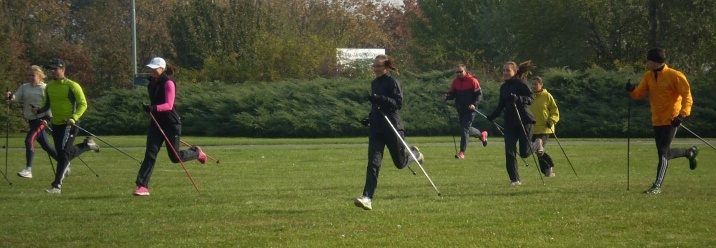We recommend the running with running poles to these groups of athletes:
Athletes after injuries
A very large target group are – unfortunately – athletes recovering after injuries, trying to regain their pre-injury fitness level, or athletes who have to reduce their training programme due to overstrain of a particular leg area. We are convinced that, apart from the medical advantages themselves, the psychological aspect is also very important: a sportsman, used to regular sports activity, will not be only walking with poles (which could lead to frustration), but will be able – within the realms of possibility – to run with a stable support of sports poles. Presumably, the activity would be carried out only on safe and flat tracks.
Endurance runners
In case of endurance runners, running with poles should become one of the regular forms of their training, mainly in difficult terrain and weather conditions (mud, snow etc.) as it enables the runner – unlike standard fartlek od free running – to reach submaximal speed without any injury risks. Thus could running with poles widen the range of commonly used training methods and by combining running with arm workout it could also suitably liven up the runner’s training, which otherwise threatens to become a bit monotonous after some time.

Putters
Shot putters, javelin, discus and hammer throwers usually have a more robust body, which brings problems with keeping stability during running. Although putters prefer workout to running out of stadium, endurance running is nevertheless a necessary basic of their general fitness training. The method of runing with poles is therefore very convenient for them since it hepls them increase running stability as well as strengthen their arms and shoulders.
Other athletes
Endurance development as a basic physical training is a key element also for other athletes. Running with poles enables them to combine running exercises with dynamical elements to develop bouncing force and power endurance (e.g. bouncing and steep uphill running). Their training is then extended with very intense outdoor training units, which they would obviously not carry out without poles.

Sportspeople with limited physical condition
We cannot leave out the people, whose current physical condition does not enable them to make full training effort. It involves mainly female athletes during pregnancy and after birth, overweight people, running beginners and occasional runners who practise only jogging. In their case it is possible to incorporate running with poles as an activity, which extends simple walking and Nordic walking by its higher intensity and emphasizes the health-preventive contributions – mainly relieving of the musculoskeletal system.
![]()



























